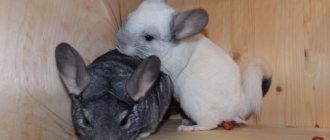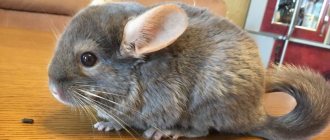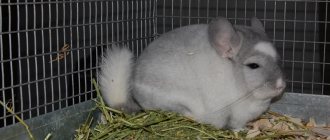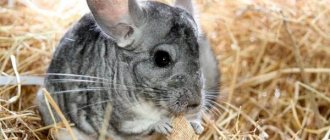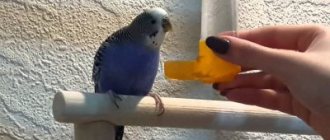Chinchillas do not bathe in water; they clean their fur in a special bathing suit, into which sand is poured. By bathing on time, the chinchilla removes dead hairs and excess moisture from its coat. Immediately after bathing, you will see that the chinchilla's fur has become clean and fluffy.
The process of bathing itself gives the chinchilla incredible pleasure. Bathing helps your chinchilla relax and relieve stress. For animal owners, this is a pleasant sight and additional time spent with their pet.
Here's what you'll need to bathe your chinchilla:
- Bathing suit purchased or made by yourself
- Sand
Watch the video of a chinchilla bathing in the sand and you will see that it is a very cute sight.
How chinchillas bathe in the sand
In the wild, chinchillas bathe in the volcanic sand of the Andean cordillera.
Sand acts as a soft abrasive and removes stuck-on dirt from the rodent's fur.
The second purpose of sand is to play the role of an absorbent so that the animal gets rid of excess moisture. As a result, conditions for the proliferation of bacteria and the appearance of parasites are suppressed.
Hygiene procedures are important for little furry. At home, these clean animals happily roll around in a bath of fine sand, periodically shaking off their luxurious coat.
The rodent spins around in the sand so energetically that small grains of sand fly around and as a result the cage becomes dusty. But this is not a reason to deprive your pet of a useful activity.
Chinchillas have small membranes in their ear canals that serve as a barrier against foreign objects entering during bathing.
Why does a chinchilla need to be washed?
Like any other animal, a chinchilla needs to be washed and bathed in order to clean its fur from adhering particles of food, dust, hay and other small objects found in the pet’s cage.
The fur of this animal is distinguished by its density, softness, shine, beauty and density. However, if the fur is rarely cleaned, the coat may lose its spectacular appearance, becoming dull and rough.
Thus, washing an animal is the most important hygienic procedure aimed at maintaining the cleanliness, shine, softness and beauty of the fur of this animal.
Important. If your pet avoids bathing for several days, it may be a sign that your pet is getting sick.
How to bathe an animal
There is no need to bathe a chinchilla in the sand; it does it itself. The owner only needs to supply a suitable bowl of sand. Ordinary sand is not suitable; you need to buy high-quality and clean filler at a pet store. River sand may contain impurities that are unnecessary for the animal. The contents of the bath are changed regularly, preventing contamination with hair and boluses.
The animal really likes to swim. If he has no other entertainment, he will do it more often than necessary. As a result, the skin will be overdried, and this should not be allowed. The tray is not left in the cage for a long time because the rodent will start using the sand bath for the toilet. Hay, feed, filler, and wool go there. As a result, the sand becomes dangerous for swimming.
What can I use instead of bathing mixture for chinchillas?
An alternative to purchased sand can be homemade sand for bathing chinchillas. Volcanic or coral sand is ideal for these purposes, but they are extremely difficult to find. You can use river water, but only the smallest fraction. You should not take regular construction sand along roads or from playgrounds.
Sand for bathing chinchillas
Before use, sand must be prepared:
- remove all debris from it and rinse thoroughly;
- bake in the oven and let cool;
- add a few teaspoons of medical sulfur to prevent parasites and talc - improves moisture absorption, makes the sand more crumbly.
This bathing mixture is a significant financial savings for those who have many individuals living with them. If there is only one animal, it is more advisable to use purchased options.
What to do if your pet doesn't want to bathe
Two weeks after giving birth, the female is already showing the cubs by example how to bathe. In another week they will be able to bathe on their own.
There are situations when the breeder’s animal was happy to bathe, but does not want to go to a new place.
Measures to take:
- take from the breeder a tray where the smell of a rodent is preserved;
- place the container lower so that the animal does not get scared;
- leave the room while the animal is bathing;
- buy sand from another company;
Under no circumstances should a rodent be forced to remain in the bathhouse against its will. This can forever cement the negative connection between the bath and the owner in the pet’s mind.
According to the observations of breeders, a young chinchilla bathes in the sand with little desire; with age, the craving for hygienic procedures increases.
When your pet refuses to bathe, eats poorly, behaves lethargically and drowsily, you need to consult a veterinarian.
There are techniques that will help reinforce the chinchilla’s desire to swim in the sand:
- Say the word “bathe” with a gentle intonation when your pet enters the bath;
- After finishing the bath, treat him with a treat.
It will take very little time for the animal to understand the benefits of bathing and begin to do it when invited.
Reasons why an animal refuses to bathe
If the female has brought offspring, then it is recommended to return the tray with sand to the enclosure no earlier than after 10 days. According to statistics, the mother begins to accustom her cubs to hygiene at the age of 2 weeks. At the same time, she shows the process of hygiene procedures from personal experience.
Many breeders note that young animals are not always enthusiastic about bathing. But over time, such negligence usually goes away.
In the case where the seller assures that the animal is familiar with the litter box, but the pet refuses to bathe, the reason may be poor adaptation to the new room and environment.
In this case, you can take the following measures:
- ask the seller for a tray or filler that retains the natural smell of the animal;
- Sometimes pets feel uneasy in a closed litter box. Therefore, it is worth changing it to an open type;
- You should not pay close attention to the procedures; this can put moral pressure on the animal. It is better to leave your pet alone during hygiene procedures.
Sometimes the reason for reluctance to bathe is an unsuitable tray filler. If there is a complete lack of interest, you should try to try different options for fillers.
The alarm should be sounded if refusal of the tray is accompanied by general lethargy and apathy of the animal.
Then you should consult a doctor in a timely manner. Such factors, taken together, indicate the presence of general health problems of a physiological nature.
Many owners wonder how to reward a chinchilla after bathing. This can be done in several ways:
- If the pet is tame, you can use voice influence. For example, each time your pet enters the tray, gently repeat the word “Bathe” several times, and then leave him alone.
- After completing the procedure, give your pet the treat he likes most.
Over time, the pet will develop a relationship between the timbre of the owner’s voice, treats and bathing procedures. If the owner is patient enough, he will be able to train the pet to bathe upon a verbal invitation.
Is it possible to bathe a chinchilla in water?
Chinchillas in the wild never bathe in water. There are good reasons why this cannot be done at home:
- The animal has a thick undercoat, and there are no sebaceous glands on the skin. Fur that is not greased immediately absorbs liquid and becomes heavy. Therefore, the rodent cannot stay afloat for long and avoids bodies of water.
- Wet wool no longer serves the function of protecting the rodent from cold and wind, and in the room from drafts. There is a high probability that the animal will get sick.
You should not bathe a chinchilla in water for the reason that the animal will be stressed, which will make it feel unhappy. When an animal's coat suddenly becomes unkempt, faded and matted, you need to show the animal to a veterinarian. The fur coat reflects the state of health.
Bathing suit
A bath for a chinchilla is a prerequisite for keeping it at home. If it is not there, the animal’s fur will become dirty, lumps will begin to form and an unpleasant odor will appear.
You can swim:
- Buy
- Do it yourself
Bathing suits are sold in almost every pet store or they can be ordered from online stores like Ozon. Their cost starts from 500 rubles. The bathing suit is a plastic container, which consists of two parts: a bottom and a lid. The lid should always be removable so that you can easily change the sand in it and completely disinfect it during general cleaning.
What characteristics should a swimsuit have:
- Closed top to prevent the chinchilla from throwing sand in different directions
- Opening lid to make it easy to clean the bathing suit and change the sand in it
- Safety. The hole should be large enough so that the chinchilla does not get stuck in it, and also that it does not have sharp edges.
To take sand, or rather dust baths, a chinchilla requires a special container - a bathing suit. If your pet bathes in an open container, sand will scatter not only throughout the cage, but also around it. Therefore, as a bathing suit, you need to choose dishes with high walls or use a container made of plastic or tin measuring 30x30x20 cm. A three-liter glass jar is also suitable for bathing purposes. Glass bathing suits are good because they make it convenient to watch your chinchilla taking a bath. In pet stores you can find various bathing suits made of plastic or ceramics (for example, a ceramic bathing suit with ears or a house-shaped design is convenient).
Whether or not to keep the bathing suit in a cage is up to you. It is best to store it next to the cage and transplant the animal there so that the sand is always clean. If you don’t have time to care for your pet and constantly change it into a bathing suit, then, of course, it is better to place it in a cage so that the chinchilla bathes itself when it needs it.
When and how to bathe a chinchilla in water
Bathing chinchillas in water is permissible if they are dirty in a substrate that is hazardous to health or in persistent and sticky mud. You should try to wash off the stained areas of the fur coat using a cotton swab dipped in warm water. Do not wash your chinchilla with scented shampoo. The animal may have allergies.
If a damp cotton swab does not solve the problem, proceed as follows:
- prepare two containers with warm water, 2-3 well-absorbent napkins and shampoo for rodents (hypoallergenic for children is possible);
- Stir a few drops of shampoo in one container;
- the pet is gently supported under the abdomen and washed until it becomes clean;
- rinse off the shampoo in the second container;
- the muzzle and ears cannot be immersed in water; they are wiped with a damp swab;
- stroking and slightly squeezing the pet, squeeze out the fur;
- Next, you need to dry the wool as quickly as possible by changing terry napkins.
If the animal responds well to the sound of a hair dryer, you can direct a stream of warm air at it. Another way is to put it in your bosom and warm it on your chest. This is done when a trusting relationship has been established between the pet and the person. All actions related to bathing and drying should be accompanied by quiet, gentle speech. The pet will be soothed by the owner's voice and the stress from contact with water will decrease.
If all these methods are unacceptable, the chinchilla can be placed on a warm (not hot) heating pad covered with a diaper. Until final drying, it is advisable to keep the pet in a carrier cage with the sides closed from drafts.
You can bathe a chinchilla only in a warm room at a temperature not lower than 23℃. You should not let the animal walk on the floor after the bath procedure.
FAQ
In order for your pet to enjoy bathing in the sand without damaging its fur and skin, it is necessary to pay due attention to the choice of bathing suit, sand and all additional accessories for washing the animal.
What you need to purchase for proper bathing of chinchillas
To wash your pet, you should purchase the most convenient container into which sand will be poured. This container must be, first of all, safe: without sharp corners and chips, and also easy to wash under water.
Most bathing suits come in two types: a small bath, which is placed in the animal’s house, or a separate terrarium, where the pet moves for half an hour to carry out hygiene procedures. The first option is considered the most convenient, but in this case the owner needs to clean both the bathing suit and the animal’s cage quite often. The good thing about the terrarium option is that the closed shape of the container will prevent sand from being scattered around.
List of necessary items for swimming:
- comfortable and safe swimsuit;
- special sand, for example, volcanic sand for bathing rodents;
- medical sulfur for fur disinfection. This product can be purchased at pet stores, but medical sulfur should be used less frequently: once every few months unless otherwise specified by the veterinarian;
- talc for shine and smoothness of wool.
You can choose suitable sand for washing your animal only from the assortment presented in pet stores . Ordinary river, sea, construction or any other sand will not be suitable for bathing your pet.
Choosing the right sand for chinchillas
When choosing a bulk filler for a bath, you should pay special attention to the quality and composition of the sand. Soft, safe sand will not scratch the skin of your hands, so you can check the quality of this product at home by lightly rubbing the grains with your fingers.
It is advisable to choose a product without quartz content. A good finished product, which is sold in pet stores, contains volcanic sand or related components: sepiolite, zeolite or soapstone.
The filler should absorb moisture and fat well.
DIY sand for chinchillas
Some owners prefer to use sand made by themselves.
This is not difficult to do; it is only important to find a high-quality starting material - zeolite, which should be crushed into crumbs and calcined in the oven. If desired, you can add a little talc to the resulting bulk product. Have you tried making sand yourself?
Why does a chinchilla eat sand?
Sometimes your pet will start eating sand for bathing, but there is nothing to worry about. The rodent does this to normalize the gastrointestinal tract, thus grinding food.
In some cases, this behavior may indicate that the pet does not have enough calcium. To replenish calcium, you can grind calcium tablets for rodents and give them a little at a time.
Additional ingredients for bathing sand
As additional ingredients in sand, you can use talc, which has a beneficial effect on the appearance of fur, as well as disinfectants, for example, medical sulfur. You can also use fungistop, which contains both sulfur and talc. The optimal dosage of fungistop for one standard bathing suit is 1 teaspoon.
It is highly not recommended to wash your chinchilla in water!
What to do if your chinchilla gets wet
If the pet gets wet, it should be removed from the water as soon as possible and wrapped in a towel that absorbs moisture well. The fur should be blotted regularly with a dry cloth.
All windows must be closed and air conditioners must be turned off. Any, even the slightest drafts should be avoided.
Periodically, the towel in which the animal dries needs to be replaced with a dry one.
You can try to dry the fur with a hairdryer, holding the device with warm air at a distance of 20 cm from the animal’s fur. If the animal is afraid of noise, turn off the hair dryer and dry the fur with a towel.
You should not let your pet into the cage before it is completely dry. During drying, the animal should not freeze.
Important. Chinchillas cannot swim, so staying in water for a long time is very dangerous for them.
What to do if your chinchilla doesn't want to bathe
Refusal to bathe may be a sign that the pet has not yet fully settled into the house. In this case, you need to give the animal more time to adapt. When the animal begins to carry out hygiene procedures, it should be praised for this with a piece of a healthy treat after washing.
If the animal suddenly stops using the bathing suit, this may indicate some health problems, so the chinchilla should be shown to a veterinarian.
Sometimes sand or a bathing suit is not suitable for your pet. You can try to replace the filler, as well as the washing container itself.
Important. You cannot force your pet to bathe.
What to do if your chinchilla gets wet
The chinchilla should be protected from contact with water. If it falls into a bucket or bowl of water, it must be removed from there immediately. She might drown.
Next, you need to take measures to dry the animal as soon as possible according to the above algorithm. If it is a cold season, you need to provide warmth in the room. In summer, turn off the air conditioner and fan, close the windows.
Swimming in water carries great risks for the animal. After a chinchilla has accidentally been in water, it must be closely monitored for 5 days.
A veterinarian is contacted when at least one of the following symptoms is present:
- discharge comes from the ears, nose, and eyes, which the animal rubs with its front paws;
- the pet is lethargic and sleepy and settles down to lie on its side;
- breathing is frequent, wheezing can be heard;
- the pet coughs;
- mucous membranes turn red;
- decreased appetite;
- the animal is thirsty or refuses to drink water;
- the pet does not respond to its name and does not want to play.
When there are no changes in the chinchilla’s health and behavior, it means that bathing did not harm. But this does not mean that a rodent can be bathed in water unless absolutely necessary. Even if he didn’t resist during the bath, it still remains a big risk.
Sand baths
Traditional baths are contraindicated for chinchillas, but sand baths are what you need. Exotic rodents love to swim not in water, but in sand. This is how they are used to cleaning their fur and maintaining hygiene.
Chinchillas “swim” in the sand with pleasure
To keep the body clean, 1-2 sand baths per week are enough for the animal. It is also convenient that the owner does not need to do anything during the bathing process - chinchillas fall out in the sand themselves with great pleasure.
How often should you bathe a chinchilla?
There is often no need to bathe your chinchilla. When the humidity in the room where the animal is located is no more than 50%, the tray is placed in the cage 2 times a week. If the humidity is high, this can be done daily.
The frequency of bathing is influenced by how often the pet is picked up and how long he walks on the floor. If, with high air humidity, the animal is not given the opportunity to bathe in the sand, a fungus may develop on its fur coat. It is often advisable to bathe a chinchilla in the sand only when necessary.
When a pet suddenly refuses its usual hygiene procedure, you need to consult a veterinarian. This is one of the alarming symptoms, which means that the animal is sick.
An instinct that has been developed in the population for centuries forces the animal to clean its coat. Clean wool means health and longevity, makes it easier to move, and makes it possible not to leave traces that will lead predators to their burrow.
DIY chinchilla bathing suit
If for some reason you cannot buy a regular bathing suit at a pet store, then you can make it yourself or take improvised containers. Many people think that making a chinchilla bathing suit with your own hands is difficult, but look at the examples below and make sure that absolutely anyone can make it.
What is suitable for bathing a chinchilla in the sand:
- Bathing suit made from a plastic water bottle. Anyone can make it, you just need to cut a hole into which the chinchilla will climb. The main thing is that the bottle is transparent. This bathing suit has another advantage: you can not wash it, but simply throw it away when it’s time to change the sand and make it from a new bottle. Make sure there are no sharp edges because the chinchilla will be very active and could get hurt.
- Fishbowl. An excellent solution, besides, you can find them used on Avito for only 100-200 rubles. The glass will last a long time, and it will be easier for the chinchilla to tumble in it due to the fact that the glass is very slippery.
- Any vessel, canister with round edges, which will be slightly larger in size than your animal
- As a bathing suit, you can use a transparent container, which will be slightly larger in size than a chinchilla.
- While your chinchillas are small, you can use a regular three-liter jar. Make sure that the chinchilla can easily fit into it and that there is enough space inside. If the jar turns out to be too small, then it is better to refuse it.
Which sand to choose
In nature, chinchillas are washed using dust that was formed as a result of a volcanic eruption. Sand for bathing chinchillas is a very conventional name. It is more correct to use the term – filler. There is a large selection of this substance on sale with pricing ranging from 100 to 300 rubles. for 1 kg. (depending on production).
The following manufacturers have proven themselves best (in terms of price-quality ratio) in our market:
- Vitakraft,
- Little One,
- Mr. Alex and others
The use of ordinary sand to clean the animal's fur is contraindicated. A rough abrasive can harm your chinchilla's delicate skin. In addition, it can cause diseases associated with exposure to harmful bacteria, which swarm in large numbers in river (sea) sand. You should always take into account that in natural conditions, a chinchilla bathes in sterile volcanic ash and sedimentary rock products. They do not contain harmful bacteria and exclude any infection of the rodent.
In order to provide the most suitable conditions for a cute furry pet, manufacturers of litter, in which washing chinchillas will be most comfortable, decided not to abuse modern technologies. Famous manufacturers use only materials of natural origin. In addition, natural materials can eliminate unpleasant odors when bathing a chinchilla. This result can be obtained using sepiolite, ziolite, etc.
From the many offers it can be very difficult to choose just one. Although usually the composition of all fillers is identical, with a difference in the size of the grains of sand. Therefore, choosing the one in which the chinchilla’s bathing will be as comfortable as possible can only be done experimentally. The sand in which the animal “takes a bath” without enthusiasm should be replaced with another.
Features of the procedure
It is better to carry out this procedure in the evening. Since it is at this time that the period of activity of the rodent falls. This way the animal will clean itself more effectively.
After each bath, it is important to sift the filler to remove any debris that has formed. Don't forget to add some fresh material regularly too.
The contents of the bathing suit should be completely renewed after 10-15 baths.
To keep the fur of the fluffy in good condition, it is important to add medical sulfur, Fungistop or crushed Nystatin to the sand. This is a kind of prevention of fungal diseases.
A negative feature of rodent bathing in sand is dust. By making turns around its axis in this material, the animal breaks the integrity of the surface, causing tiny specks of dust to rise up and then settle everywhere. Therefore, it is better to carry out this procedure in the bathroom , where everything can be easily wiped with a damp cloth.


